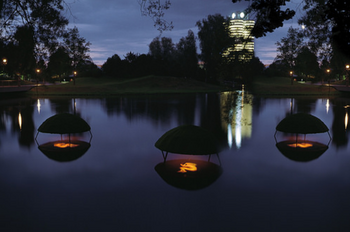Saint Alban Islands
Coat of arms
| |
| Motto: "Strength through unity" | |
| Anthem: United we stand | |
 | |
| Capital | Tutabanoa (Alban's Landing) |
| Official languages | English, Alemannic, Gagana Sin'abanoa |
| Ethnic groups (2018) |
|
| Demonym(s) | English: Saint Albanese
German: Sankt-Albanese/St.Albanesin Polynesian: Tagata Sin'abanoa |
| Government | Federal dominant party socialist republic |
• President | George Taua'alo |
• Prime Minister | Talia Maivia |
| Legislature | Federal Convention |
| Independence from WIP2 | |
| 1 January 1720 | |
• Treaty of WIP/Colonisation by WIP2 | 1 January 1760 |
• Semi-autonomous Colony of WIP2 | 1 January 1820 |
• Crown Colony | 1 January 1939 |
• Declaration of independence | 1 January 1949 |
| Area | |
• Total | 2,306 km2 (890 sq mi) |
| Population | |
• 2015 census | 307,190 |
• Density | 133.2/km2 (345.0/sq mi) |
| GDP (PPP) | 2014 estimate |
• Total | 2.106 billion ₮ |
• Per capita | 6.857 ₮ |
| GDP (nominal) | 2014 estimate |
• Total | 1.459 billion ₮ |
• Per capita | 4.749 ₮ |
| Gini (2016) | 24.3 low |
| HDI (2015) | 0.689 medium |
| Currency | Saint Alban tālā (₮) (SAT) |
| Time zone | UTC+10 |
| Date format | dd/mm/yyyy |
| Driving side | right |
| Calling code | +93 |
| Internet TLD | .sa |
WIP Introduction
Etymology
WIP
History
Antiquity
WIP
Colonial history
The ? missionary Alban was sent to region by King/ Queen ... in order to "civilize" and convert the local population to religion1. Together with the crew of the Carrack Seeadler and its captain ... they landed on today's Eagle's Landing on the westernmost island in October 1674. Ten men left the carrack together with the missionary and built a small station where they were first met by a local tribe, what happened next can only be speculated about. When ... returned to the islands in July 1675 all traces of the priest and his men were gone.
TBD
A bit less than half a century later in 1720 ... "conquistadores" arrived proclaiming the islands a part of the new colony of Saint Alban, named after the first missionary to arrive there.
TBD
In 1760 the colony was given/sold to ?? in the Treaty of .... At that time King/Queen ... didn't see the islands as too valuable because of the constant infighting between rivaling tribes and occasional attacks on colonial settlements. In 1762 ?? began arming the warriors of King Ata'mōri I. who soon after gained control of the biggest island Motu Oketi, while ?? began forcefully occupying the smaller surrounding islands and converting the local tribes. Appreciating ??'s help Ata'mōri I. converted to religion2 and granting settlers more coastal land.
TBD
Between 1783 and 1835 the islands were flooded by several waves of white immigrants when massive pearl beds were found in the reefs surrounding the islands. Many of these early settlers were able to make a decent living. A new white middle- and upper class established itself much to the disappointment of the (aristocratic) indigenous population which has been subjected to corvée labour even after religious conversion. Settlers who failed in business or didn't make enough profit to reinvest in plantations, farms, shipping companies or other enterprises dropped in their societal status all the way down to the indigenous people. Many of these impoverished whites went back to their home countries, still, a fair amount of them stayed and merged with the locals living at the brink of society thus forming a multiracial lower class group which exists until today.
The Pearl-Boom slowly died down and finally ended in 1837 with the migration of the first pearl-diving businessmen and the following exodus of lower class opportunists who only came for quick business.
The middle class was still able to make a reasonable living with small farms with imported goods like cattle and sugar cain as well as taro and yams. The upper class sustained itself by large scale plantations of Cocoa, Kopra and Tobacco. The lower class consisting of impoverished white colonists, "Mestizos" and indigenous People lived from subsistence farming and fishing.
WIP
After independence(/Apartheid)
WIP
1st free elections/Crisis/Insurgency
WIP
Modern
WIP
Geography
WIP
Climate
WIP
Environment
WIP
Politics
Government
WIP
Human rights
WIP
Administrative divisons
WIP
Foreign relations
| Country | Status | Current state of relations | Mutual Embassies | Visa Requirement | Saint Albanese Ambassador | Country's Ambassador to SAI |
|---|---|---|---|---|---|---|
| Feel free to add our mutual relations | Ambassador SAI | Ambassador Country | ||||
| WIP | WIP |
Law and justice
WIP
Military
WIP
Economy
WIP
Tourism
WIP
Transport
WIP
Energy
WIP
Infrastructure
WIP
Demographics
WIP
Ethnic groups
WIP
Languages
WIP
Religion
WIP
Education
WIP
Culture
WIP
Media
WIP
Sport
WIP